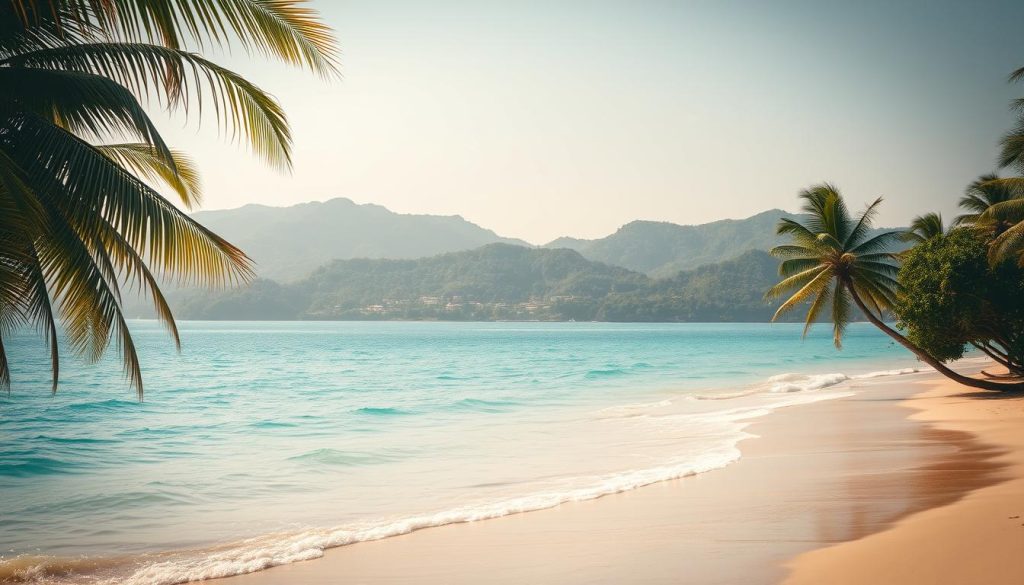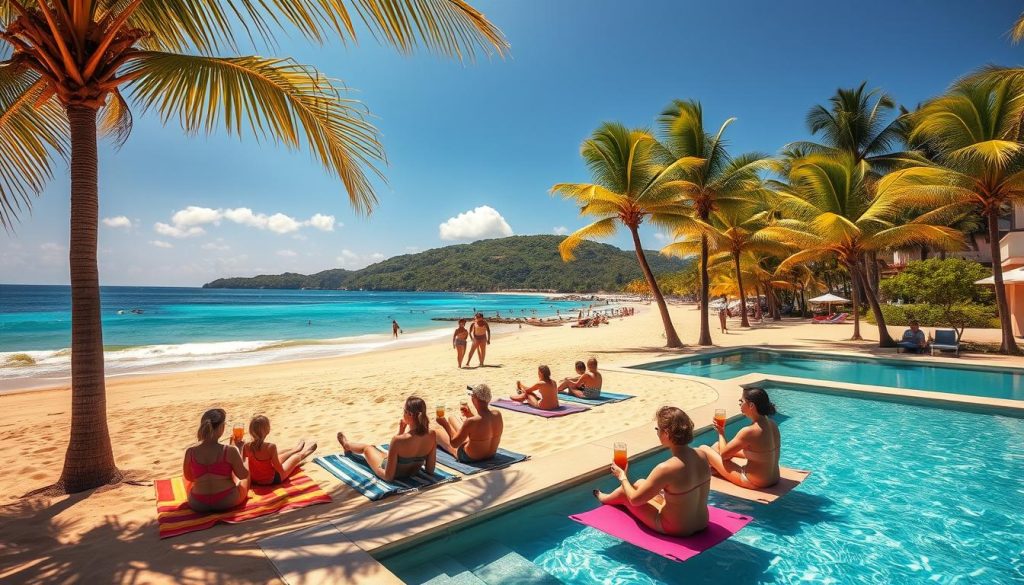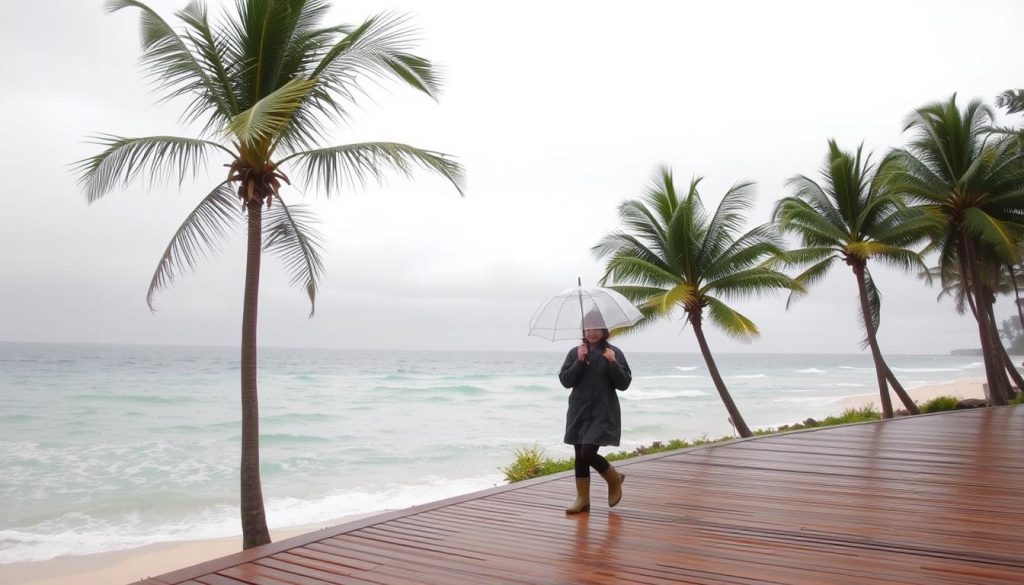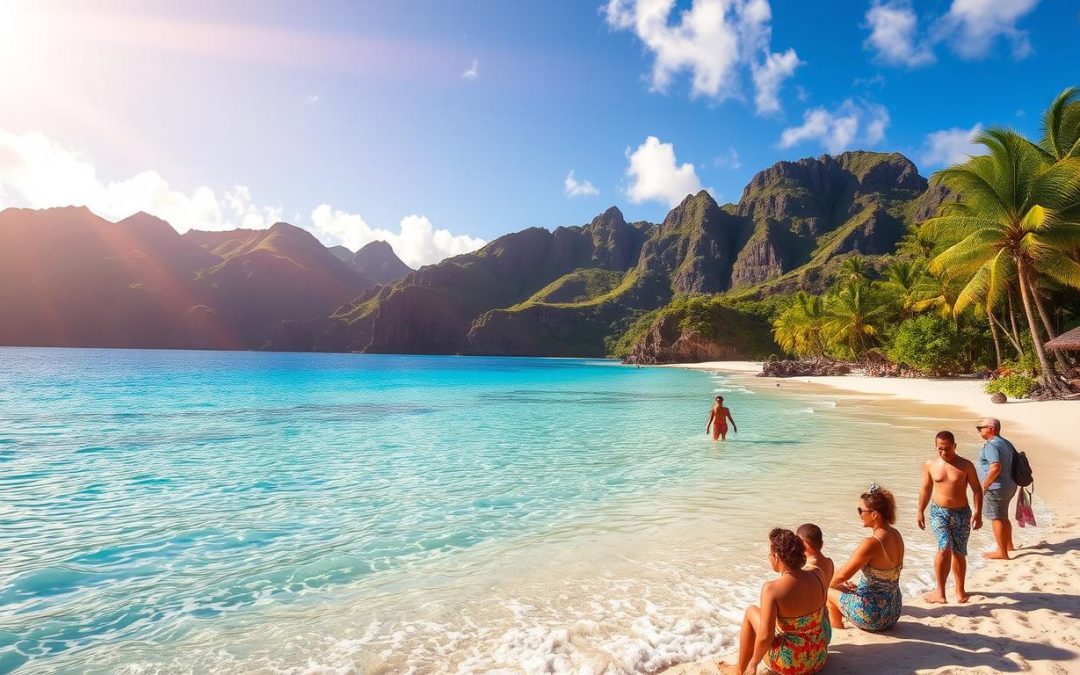Have you ever wondered where you can find a tropical paradise with consistent warm weather all year round? Look no further than this stunning island destination. Its unique climate makes it a standout choice for travelers seeking a reliable escape from unpredictable weather patterns.
With temperatures ranging from 77°F to 88°F throughout the year, this island offers a warm and inviting atmosphere no matter when you visit. Unlike other tropical destinations, the weather here remains steady, with minimal variations between seasons. This makes it an ideal spot for planning your trip without worrying about sudden changes.
Whether you’re looking to relax on pristine beaches or explore lush landscapes, this island has something for everyone. Its clear skies and warm breezes create the perfect backdrop for unforgettable adventures. Ready to discover why this destination is a year-round favorite? Let’s dive into the details!
Key Takeaways
- Enjoy warm temperatures ranging from 77°F to 88°F all year.
- Experience minimal weather variations compared to other tropical destinations.
- Plan your trip with confidence, thanks to consistent climate conditions.
- Explore pristine beaches and lush landscapes in any season.
- Discover why this island is a top choice for weather-savvy travelers.
Introduction to American Samoa’s Climate
Planning a trip to a tropical destination? Understanding the climate is key. This island boasts a tropical maritime climate, with warm temperatures and consistent weather patterns year-round. Whether you’re planning a beach day or an outdoor adventure, knowing what to expect can make all the difference.
Setting the Stage for Your Trip
When you’re preparing for your getaway, the weather plays a big role. This island’s climate is characterized by warm days and mild nights, making it perfect for outdoor activities. The temperature rarely dips below 77°F, ensuring you’ll always have comfortable conditions.
Understanding the climate helps you pack wisely and plan your itinerary. For example, knowing the time of year with the least rainfall can help you avoid unexpected showers. This way, you can focus on enjoying your trip without worrying about the weather.
“The climate here is a traveler’s dream—consistent, warm, and inviting.”
Why Climate Matters for Your Travel Plans
Considering the weather trends is essential for a smooth trip. Here’s why:
- Daytime conditions affect outdoor activities like hiking, swimming, and sightseeing.
- Understanding rainfall patterns helps you choose the best time to visit.
- Knowing the temperature range ensures you pack the right clothing.
By taking these factors into account, you can create a travel plan that maximizes your enjoyment and minimizes surprises. Ready to dive deeper into what makes this island’s climate so special? Let’s explore further!
Understanding Year-Round Warm Temperatures
If you’re looking for a destination with steady warmth, this island delivers. Its tropical climate ensures that temperatures stay comfortably between 77°F and 88°F throughout the year. This consistency makes it a standout choice for travelers who want to avoid extreme weather changes.

Unlike other destinations, this island experiences minimal temperature variation. Whether you visit in November or any other month, you’ll find the weather remains warm and inviting. This predictability makes it easier to plan your activities without worrying about sudden shifts in conditions.
Exploring Temperature Ranges
The island’s climate is characterized by its steady warmth. Daytime highs rarely exceed 88°F, while nighttime lows stay comfortably above 77°F. This range ensures that you’ll always have pleasant conditions for outdoor adventures or relaxing on the beach.
Insights on Minimal Variation
One of the most appealing aspects of this destination is its lack of extreme weather. There are no scorching summers or chilly winters here. Instead, the climate remains consistently warm, making it an ideal spot for vacationers at any time of year.
Here’s a quick overview of the island’s temperature averages:
| Month | Average High (°F) | Average Low (°F) |
|---|---|---|
| November | 86 | 78 |
| December | 87 | 77 |
| January | 88 | 78 |
Whether you’re planning a trip in November or another month, you can expect similar conditions. This stability makes it easier to pack and plan, ensuring your trip is as enjoyable as possible.
American Samoa Weather Patterns Explained
Understanding the weather patterns can make your trip even more enjoyable. The island’s climate is shaped by a mix of sunshine and occasional rain, creating a balanced experience for travelers. Whether you’re exploring beaches or hiking trails, knowing what to expect helps you plan better.
Cloud Cover and Sunshine Trends
Cloud cover and sunshine play a big role in shaping the island’s daily weather. January tends to be cloudier, while August offers clearer skies. These trends affect how warm or cool the day feels, even though temperatures remain steady.
For example, October brings a mix of sun and intermittent rain, making it a great time to visit. The balance between clear and overcast conditions ensures you get the best of both worlds.
Highs and Lows: A Look at Daily Temperatures
Daily temperatures here are consistent, with highs rarely exceeding 88°F and lows staying above 77°F. This stability makes it easy to plan outdoor activities without worrying about sudden changes.
Here’s a breakdown of the island’s weather patterns:
| Month | Average High (°F) | Average Low (°F) | Cloud Cover |
|---|---|---|---|
| January | 88 | 78 | High |
| August | 87 | 77 | Low |
| October | 86 | 78 | Moderate |
Knowing these patterns can enhance your overall experience. Whether you’re visiting in October or another month, you’ll be prepared for the island’s unique climate.
Best Time for Beach and Pool Activities
Looking for the perfect time to enjoy water activities under the sun? Mid-June to late September is the ideal period for beach and pool fun. During these months, clear skies and warm temperatures create the perfect conditions for outdoor adventures.

Peak Months for Outdoor Water Fun
From mid-June to late September, the island experiences low rainfall and consistent warmth. This makes it the best time visit for swimming, snorkeling, and other water sports. The weather is reliable, so you can plan your activities without worrying about sudden changes.
If you prefer milder conditions, April offers a transitional period. The temperatures are slightly cooler, but the weather is still pleasant for outdoor fun. This is a great option for those who want to avoid the peak season crowds.
“Timing your visit during these months ensures you get the most out of your beach and pool adventures.”
Here are some tips to maximize your enjoyment:
- Pack light, breathable clothing for the warm weather.
- Bring sunscreen and stay hydrated during outdoor activities.
- Plan your water sports early in the day to avoid the midday heat.
By choosing the right time visit, you can make the most of your trip. Whether you’re diving into crystal-clear waters or relaxing by the pool, these months offer the best conditions for outdoor fun.
Overview of Precipitation Trends
When planning your trip, understanding rainfall patterns can make all the difference. The island experiences distinct wet and dry seasons, each offering unique opportunities for travel and activity. From October to May, the wet season brings heavier rains, while June to September is marked by drier conditions.
Seasonal Rainfall Distribution
The wet season, spanning October to May, sees the highest rainfall, with January recording the most wet days. During this time, occasional showers are common, but the overall climate remains warm and inviting. This makes it a great time for indoor activities or exploring lush landscapes.
In contrast, August is the driest month, with minimal rainfall and clear skies. This period is ideal for outdoor adventures like hiking, swimming, and snorkeling. Understanding these trends helps you choose the best time for your preferred activities.
Even during the wetter months, the island’s warm temperatures ensure a pleasant travel experience. By aligning your plans with rainfall forecasts, you can minimize disruptions and maximize enjoyment.
“Knowing when to visit can transform your trip into a seamless and memorable adventure.”
Here’s a quick guide to help you plan:
- Visit from June to September for dry, sunny days perfect for outdoor activities.
- If you prefer lush greenery, the wet season from October to May offers a vibrant landscape.
- Pack lightweight rain gear for unexpected showers during the wetter months.
By understanding these precipitation trends, you can make informed decisions and enjoy your trip to the fullest. Whether you’re exploring beaches or hiking trails, the island’s climate ensures a warm welcome year-round.
American Samoa: Best Months for a Weather-Savvy Trip
Choosing the right time to visit a tropical destination can greatly enhance your experience. By understanding the weather patterns, you can plan your trip to align with your preferences, whether you’re seeking sunny skies or lush green landscapes.
From May to October, the island enjoys its peak tourism season. During these months, you’ll find clear skies, warm temperatures, and minimal rainfall. This is the ideal period for beach activities, hiking, and exploring the island’s natural beauty.
If you prefer a quieter visit, consider traveling from November to April. While this is the wetter part of the year, the rain often comes in short bursts, leaving plenty of time for outdoor adventures. Plus, the island’s landscapes are at their most vibrant during this time.
Here’s a quick overview of the best months to visit based on weather data:
| Month | Average High (°F) | Rainfall (inches) | Sunshine (hours/day) |
|---|---|---|---|
| May | 87 | 3.5 | 8 |
| June | 88 | 3.0 | 9 |
| July | 88 | 2.8 | 9 |
| August | 87 | 2.5 | 9 |
| September | 87 | 3.0 | 8 |
| October | 86 | 4.0 | 7 |
Every part of the year offers something unique. Whether you’re drawn to the dry season’s sunny days or the wet season’s lush scenery, careful planning can optimize your tourism experience. Weigh the chance of rain against the clear, sunny conditions to decide what works best for you.
“Timing your trip to match your preferences ensures a memorable and enjoyable adventure.”
By considering these factors, you can make the most of your visit and create lasting memories. Ready to start planning? The island’s warm welcome awaits!
Exploring Tourist Scores and Outdoor Activity Insights
Understanding how tourist scores work can help you plan the perfect outdoor adventure. These scores are calculated based on factors like temperature, cloud cover, and precipitation. They provide a clear picture of the best times to visit for activities like hiking, swimming, or exploring a national park.
Tourism and Beach/Pool Scores Analysis
Tourist scores are particularly useful for identifying the peak periods for outdoor fun. For example, August often scores high due to its warm temperatures and clear skies. This makes it an ideal time for beach and pool activities.
Even in March, when the weather is transitioning, these scores can help you find favorable travel windows. Whether you’re planning a trip throughout the year or during a specific season, understanding these metrics ensures you make the most of your visit.
Here’s how tourist scores correlate with popular activities:
- High scores indicate perfect conditions for visiting a national park or enjoying water sports.
- Moderate scores suggest good weather for hiking or sightseeing, even if there’s occasional cloud cover.
- Lower scores may signal rainier periods, but they’re still great for exploring indoor attractions.
To give you a clearer picture, here’s a summary of tourist scores and their impact on travel planning:
| Month | Tourist Score | Beach/Pool Score | Best Activities |
|---|---|---|---|
| March | 7.5 | 6.8 | Hiking, Sightseeing |
| August | 9.2 | 9.5 | Swimming, Snorkeling |
| October | 8.0 | 7.9 | Exploring National Parks |
By using these scores, you can align your travel plans with the best weather conditions. Whether you’re visiting during the peak season or a quieter month, this data ensures a memorable and enjoyable trip.
“Tourist scores take the guesswork out of planning, helping you focus on what matters most—enjoying your adventure.”
Seasonal Variations and Their Impact on Travel
Seasonal changes can significantly shape your travel experience, especially in a tropical setting. Understanding these variations helps you plan better and make the most of your trip. Whether you’re attending a festival or exploring outdoor attractions, knowing what to expect ensures a smoother journey.
The island experiences distinct periods of clearer skies and cloudier days. These shifts influence outdoor activities and event attendance. For example, May often brings clearer skies, making it a popular time for cultural celebrations and festivals.

Clearer vs. Cloudier Periods
Clearer skies are ideal for outdoor adventures and large gatherings. During these times, wind patterns are usually calmer, creating a pleasant atmosphere for exploring. Cloudier periods, on the other hand, may bring occasional rain but also cooler temperatures, which can be refreshing.
Here’s how seasonal variations impact travel experiences:
- Clearer skies in May attract larger crowds to festivals and outdoor events.
- Cloudier days are perfect for indoor activities or exploring lush landscapes.
- Wind patterns during different seasons shape the overall ambience of the island.
Choosing the right time to visit can enhance your experience. For instance, planning your trip around major cultural events ensures you don’t miss out on the island’s vibrant traditions.
Here’s a quick overview of seasonal variations and their impact:
| Season | Sky Conditions | Best Activities |
|---|---|---|
| May | Clearer skies | Festivals, Outdoor Events |
| October | Cloudier days | Indoor Activities, Sightseeing |
| August | Clear skies, Calm winds | Beach Activities, Hiking |
By aligning your travel plans with these seasonal trends, you can optimize your trip and enjoy every moment. Whether you’re attending a festival or exploring the island’s natural beauty, understanding these variations ensures a memorable experience.
“Timing your visit to match the season’s unique offerings ensures a richer and more enjoyable adventure.”
Practical Travel Tips for Your American Samoa Trip
Planning your trip to a tropical destination requires thoughtful preparation, especially when it comes to weather. Even with stable temperatures, unexpected rain or wind can occur. Being ready ensures you can enjoy every moment, whether you’re exploring a park or diving into crystal-clear water.
Navigating Weather Uncertainties
Weather in tropical regions can change quickly. Even in June, which is typically dry, occasional showers are possible. To handle these shifts, check real-time updates before heading out. Apps like Weather.com or AccuWeather can provide accurate forecasts.
When planning your trip, balance indoor and outdoor activities. This way, you’re prepared for any weather surprises. For example, pair a morning hike with an afternoon visit to a local museum or cultural site.
Recommendations on Packing and Gear
Packing smart is key to a smooth trip. Bring lightweight rain gear, such as a compact jacket, to stay dry during sudden showers. Sun protection is equally important—pack sunscreen, a wide-brimmed hat, and sunglasses.
For water activities, consider quick-dry clothing and water shoes. If you’re visiting a park, sturdy hiking boots and a reusable water bottle are essential. Layering is also a great strategy, as it allows you to adapt to changing conditions.
- Lightweight rain jacket
- Sunscreen and sun protection accessories
- Quick-dry clothing for water activities
- Sturdy footwear for hiking or exploring a park
- Reusable water bottle and snacks
“Preparation is the key to turning weather uncertainties into opportunities for adventure.”
By following these tips, you’ll be ready to make the most of your trip, no matter what the weather brings. Whether you’re relaxing by the water or exploring a lush park, thoughtful planning ensures a memorable experience.
Safety and Preparedness During Rainy or Windy Seasons
Traveling to a tropical destination means preparing for varying weather conditions, especially during rainy or windy seasons. High winds and increased humidity can pose challenges, particularly near the beach. Staying safe requires awareness and proactive measures.

Staying Safe in High Wind Conditions
High winds are common in a tropical climate, especially during stormy periods. To stay safe, avoid open areas and seek shelter in sturdy buildings. If you’re near the beach, be cautious of flying debris and strong waves.
Here are some practical tips for handling high winds:
- Secure loose objects like umbrellas or chairs to prevent them from becoming hazards.
- Stay indoors during severe windstorms and avoid windows.
- If you’re caught outside, find a low-lying area and protect your head.
Precautions for Water Activities
Water activities can be risky during windy or rainy seasons. Always check weather forecasts before heading out. If storms are predicted, postpone your plans to ensure safety.
When engaging in water sports, follow these guidelines:
- Wear a life jacket, even if you’re a strong swimmer.
- Avoid venturing too far from the shore during unstable weather.
- Be aware of sudden changes in wind direction or water currents.
Staying Informed Through Weather Updates
Reliable weather updates are essential for staying safe. Use apps like Weather.com or AccuWeather for real-time forecasts. These tools can help you plan your activities and avoid unexpected weather changes.
“Preparation is the key to turning weather uncertainties into opportunities for adventure.”
By staying informed, you can make better decisions and enjoy your trip without unnecessary risks.
Practical Tips for Handling Humidity
High humidity can make outdoor activities uncomfortable. Stay hydrated and wear lightweight, breathable clothing. If you’re near the beach, take breaks in shaded areas to avoid overheating.
Here’s how to manage high humidity:
- Drink plenty of water throughout the day.
- Use sunscreen to protect your skin from the sun’s intensity.
- Plan activities during cooler parts of the day, like early morning or late afternoon.
By following these tips, you can stay safe and comfortable, even during challenging weather conditions.
Planning Activities Based on Weather Statistics
Planning your daily activities around weather statistics can make your trip more enjoyable and efficient. By analyzing trends, you can align your schedule with periods of lower crowds and favorable conditions. This approach ensures you make the most of your time, whether you’re exploring popular attractions or relaxing in quieter spots.
Understanding patterns in January and other months can help you avoid heavy crowds. For example, January often sees fewer visitors, making it an ideal time year for a more intimate travel experience. By visiting during off-peak periods, you can enjoy shorter lines and a more relaxed atmosphere.
- Check weather forecasts to identify days with clear skies and comfortable temperatures.
- Visit popular attractions early in the morning or late in the afternoon to avoid peak crowds.
- Plan indoor activities for days with higher chances of rain or wind.
Choosing the right time year can also enhance your experience. For instance, traveling during shoulder seasons often offers a balance of good weather and fewer tourists. This allows you to explore at your own pace without feeling rushed.
“Data-driven decisions ensure your trip is both enjoyable and stress-free.”
By using weather statistics to guide your plans, you can optimize your itinerary and create lasting memories. Whether you’re visiting in January or another month, thoughtful planning ensures a smoother and more rewarding adventure.
Tools and Resources for Real-Time Weather Updates
Staying updated with real-time weather information is essential for a smooth and enjoyable travel experience. Reliable tools and mobile apps provide accurate forecasts, helping you adjust your plans and stay safe. Whether you’re exploring a national park or attending a local culture event, these resources ensure you’re always prepared.
Reliable Mobile Apps and Websites
Several apps and websites offer real-time weather updates tailored to your location. Apps like Weather.com and AccuWeather provide detailed forecasts, including temperature, precipitation, and wind speed. These tools are especially useful during december, when weather conditions can change quickly.
For travelers, these apps also offer alerts for severe weather, ensuring you’re informed about potential risks. By using these resources, you can plan your activities with confidence, knowing you’re prepared for any weather surprises.
How to Interpret Local Weather Data
Understanding local weather data is key to making informed decisions. Look for trends in temperature, humidity, and wind patterns to plan your day effectively. For example, if rain is predicted in the afternoon, schedule outdoor activities for the morning.
Here’s a quick guide to interpreting weather data:
- Check hourly forecasts for the most accurate updates.
- Monitor wind speeds if you’re planning water activities.
- Use humidity levels to decide on appropriate clothing.
These tools also provide information on national weather alerts, helping you stay safe during extreme conditions. By staying informed, you can adapt your plans and make the most of your trip.
“Real-time weather updates take the guesswork out of travel planning, ensuring a seamless and enjoyable experience.”
Here’s a summary of recommended apps and their features:
| App/Website | Key Features |
|---|---|
| Weather.com | Hourly forecasts, severe weather alerts |
| AccuWeather | Detailed precipitation maps, wind speed updates |
| National Weather Service | Official alerts, long-term forecasts |
By using these tools, you can stay ahead of the weather and focus on enjoying your adventure. Whether you’re visiting in december or another month, these resources ensure a stress-free and memorable trip.
Conclusion
Exploring a tropical destination becomes seamless when you understand its weather patterns. This guide highlights the benefits of visiting a place with a stable climate, where clear skies and warm temperatures dominate most of the year. By aligning your trip with periods of low storm activity, you can enjoy outdoor adventures without interruptions.
Understanding these patterns ensures a safer and more enjoyable experience. Whether you’re planning beach days or cultural explorations, this guide serves as a valuable resource. Use it to choose the best times for your visit, avoiding unexpected weather surprises.
With careful planning, you can maximize your time in this beautiful location. Remember, knowing the weather trends transforms your trip into a stress-free and memorable adventure. Start planning today and embrace the island’s warm welcome!
The above is subject to change.
Check back often to TRAVEL.COM for the latest travel tips and deals.
